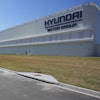Aggressive investments in personnel and equipment, as well as proactive approaches to market trends, have helped Davisco build its cheese processing operations.
“Float like a butterfly, sting like a bee,” is how boxing legend Muhammad Ali described his approach in the ring. And while neither family-owned Davisco Foods’ or their Lake Norden, South Dakota cheese factory are looking to pick a fight, parallels to this famous quote can be drawn in the way Davisco operates with extreme fluidity in making quick decisions that deliver a big impact for the company and customers like Kraft Foods.
Davisco is an international cheese and food ingredient company headquartered in Le Seur, Minnesota, with additional cheese and whey processing facilities throughout the upper Midwest in Minnesota, Idaho and South Dakota. At the Lake Norden, South Dakota plant, which was purchased in the early 1980s from Land O’ Lakes, Davisco processes over 3.2 million pounds of raw milk each day, originating primarily at farms in South Dakota, but also extending out to neighboring Iowa and North Dakota dairy farms as well.
This incoming milk is transformed to six, 10, 20 or even the occasional 40-pound block of provolone, mozzarella or parmesan. While the facility and company can handle other varieties of cheese, such as cheddar, these are the types presently offering the most demand and opportunity. The Lake Norden facility produces a total of 115 million pounds of cheese each year, equal to about one-third of Davisco’s total annual output.
Handling such quantities obviously demands a commensurate facility in terms of space and resources. However, perhaps what is most impressive about the 275,000-square-foot facility, with 100,000 square feet of refrigerated and dry ingredient warehouse space, is that it has been designed to get even bigger.
A 2005 expansion took the plant to its current footprint, and included taking steps to accommodate future growth, as positions for doors and other work flow adjustments were integrated into the layout during construction. This underscores that butterfly and bee mentality that has influenced investment decisions throughout the company’s history — smooth and efficient operations with the ability to strike quickly when growth opportunities present themselves.
The Whey Forward
Davisco's Lake Norden facility has invested heavily in advanced automation equipment, and their next primary target for continued investment will be the packaging area of their operations. |
“Being family-owned, there are no board meetings or multiple levels of approval,” states Marvin Bartlett, Davisco’s director of engineering. “We can act quicker, which is a competitive advantage,” he says, in describing an investment strategy centered on automating more processes and hiring more people that can be trained to ensure optimal performance of that new equipment. “This company has never been afraid to invest in technology that will improve quality and efficiency,” adds Lake Norden plant manager Todd Pennings.
The company’s automation investment history really began in the early 1990s with its Jerome, Idaho facility. With the efficiencies it realized through greater use of instrumentation and controls, that location quickly tripled its capacity. Davisco then took the same approach with production facilities in La Seur and Lake Norden. Now the challenge is finding new areas that can be automated in expanding operational efficiencies without impacting quality or flexibility in providing customer-based variations of recipes and packaging.
“Whenever we bring in new equipment, there’s always a focus on not only improving efficiency but protecting the quality and consistency of the end product,” adds Pennings. “And that means looking at all aspects of production flow — from getting the milk out of the tanker trucks all the way to packaging.”
Some examples of how this increased automation has improved production include:
- Data acquisition that allows for collecting and scrutinizing information that can be benchmarked in order to better understand how all the production processes can be improved. This not only breeds cost-saving efficiencies but also ensures product consistency.
- Seeing these investments in equipment and real-time information tracking also produces a greater sense of customer confidence. This has led to not only retaining current customers but also tapping into growth markets like mozzarella for pizza makers.
- Remote monitoring and data tracking allow for greater and more immediate support to be given to the Lake Norden and Jerome facilities from headquarters in La Suer.
“We invested in a bunch of cameras all over the facility, with the dual goal of improving quality and security,” recalls Jon Davis, Davisco's COO. “What we learned is that it actually became a great monitoring, safety and customer assurance benefit. When something negative happened, either from a production or worker safety perspective, we could look at the tape and see what happened. Our workers know it’s not a ‘Big Brother’ thing, just another way to pinpoint ways of improving our operations and, ultimately, the finished product.”
Equipment investments span the entire 275,000 square foot facility, from the truck bay where milk is received to packaging, where a Columbia/Okura A1600 robotic palletizer helps streamline operations. |
According to Troy Ammann, Davisco’s director of cheese operations, “these investments allow us to produce in large quantities for bigger customers but simultaneously provide the flexibility and customized touches of a smaller, specialty cheese maker. That’s a unique advantage to hold and it stems from the company’s openness to investing in new equipment and specially-trained employees. We really provide our customers the best of both worlds in terms of our ability to provide large quantities of customized product.”
In addition to branching out into the dairy protein side of the business, the Lake Norden facility also uses custom drying equipment in a separate part of the plant to produce a variety of food ingredients. So their investments in new technology have not only allowed Davisco to grow their core business, but expand into new market segments as well.
While operating in a town with a population of 432 can have its advantages, the company’s growth also meant it would need to build its own wastewater treatment facility, as the village of Lake Norden simply couldn’t handle the added strain. Now, the plant’s water is treated on 635 acres of open wetlands directly behind the facility.
Like many manufacturers, Davisco has begun to look beyond just the efficiency-related cost savings to examine how these equipment investments can help cut energy costs. “Even though things have leveled out lately, there was a while where high oil prices impacted the cost of everything from grain prices that increase the farmer’s costs to transportation to cleaning chemicals to packaging materials,” offers Pennings.
“This led us to look at a lot of different things. We replaced a lot of lighting and integrated motion sensors that help control energy usage. If nobody is in the pasteurization room, the lights don’t need to be on, so we’re being more energy conscious in helping to control costs,” he adds.
Davisco has put plans in motion to cut utility and energy consumption by 25 percent over the next five years. This stems not only from wanting to realize current cost savings, but in anticipation of even higher energy costs on the horizon that will stem from a potential federal mandate on coal-burning plants that will directly impact energy costs.
Maximizing Manpower
Bartlett and Pennings are quick to point out that Davisco’s investments are never focused exclusively on new equipment or production-focused products. The addition of people — the right people — always plays a key role in the growth of any successful venture.
“In a town of 432, we have over 200 employees, and they all have an excellent work ethic,” states Pennings. “Everyone works hard to improve every area of the operation, which leads to a better quality product and growth that keeps the company running in a positive direction.”
At each of their production facilities Davisco has automation teams consisting of 10 to 15 people that are dedicated to the design, reporting and integration of automation processes and equipment. Additionally, maintenance staff is focused on preventative and predictive maintenance that includes advanced approaches to thermographic readings in identifying areas where excess heat is being given off by electrical equipment. Other members of this team will focus on vibration and motor analysis to determine if immediate steps need to be taken before a time and money-consuming shut-down occurs due to mechanical issues.
Although it is capable of handling huge quantities, the Lake Norden facility strives to maintain the approach of a specialty cheesemaker. |
“These approaches and investments in personnel have led to less unscheduled downtime and fewer product quality concerns. And it’s not like our employees are just dropped into these positions. They're well-trained and involved from the ground up in everything we do,” states Pennings.
Keeping employees involved and investing in their success has been a vital component of Davisco’s growth. As the business has grown so has the attention that must be paid to product quality, especially from customers.
“As we’ve grown, there have continued to be more third-party and customer-directed quality assurance audits,” states Bartlett. “One of our constants is that we’re always quick to react to customer feedback. So whether it comes out in one of these audits, directly from customer • interaction, or the mock recalls that we might run or participate in with our customers, we need our people to be ready to respond.
“That’s where the investments in employees and processes really come to fruition. Paying attention to every detail provides reassurance that Davisco is continuing to provide a high-quality product that they can trust. This also helps us stay ahead of the customer in terms of what they want and need instead of waiting for them to point it out to us,” he continues.
As previously mentioned, the company is ready for their next expansion, which is probably more a question of when than if. Product demand continues to grow and the company’s geographic position should be beneficial in tapping the region's growing milk shed.
One of the more interesting sections of the Lake Norden plant is a small kitchen located above the production floor and amongst a collection of offices and conferences rooms. This kitchen is used to test the company’s cheese by melting it on pizza. Compared to the technology found on the plant floor, a pizza oven is a small investment to make. However, this simple process also seems like the perfect way to reinforce what appear to be Davisco’s core principles — connecting with people, always focusing on quality, and staying on top of what everyone wants.
| The following companies have contributed to the overall success of the Davisco facility: | |
• AGC
Engineering |
• Fristam |


















